Red Fox
Vulpes vulpes
The red fox actually has many different variations of fur, including silver and brown.
Advertisement
Red Fox Facts
- Prey
- Rabbits, mice, voles, birds, frogs, fish, eggs, and fruits and vegetables
- Name Of Young
- Kits or pups
- Group Behavior
- Family units
- Fun Fact
- The red fox actually has many different variations of fur, including silver and brown.
- Estimated Population Size
- Millions
- Biggest Threat
- Hunting
- Most Distinctive Feature
- The bushy tail
- Other Name(s)
- Silver fox or cross fox
- Gestation Period
- 49-55 days
- Litter Size
- 1-13
- Habitat
- Forests, grasslands, tundra, prairie, deserts, and mountains
- Predators
- Wolves, cougars, lynxes, bobcats, eagles, and owls
- Diet
- Omnivore
- Average Litter Size
- 1-13
- Common Name
- Red fox
- Number Of Species
- 1
- Location
- North America, Europe, Asia, North Africa, and Australia
Red Fox Physical Characteristics
- Color
- Brown
- Grey
- Red
- Black
- Silver
- Skin Type
- Hair
- Top Speed
- 31 mph
- Lifespan
- 2-4 years in the wild, 10-12 in captivity
- Weight
- 6.5-24 lbs
- Height
- 16 inches
- Length
- 36-42 inches
- Age of Sexual Maturity
- 10 months
- Age of Weaning
- 56-70 days
View all of the Red Fox images!
Garbed in its customary red, silver, or brown fur, the red fox is among the most common carnivorous mammals in the world.
This species is a tenacious and wily survivalist in the wild. The red fox is an animal that has learned to thrive in many different climates and habitats, from steep mountain cliffs to flat and featureless deserts. The red fox seems like a natural part of our landscape, having adapted to life near humans, and yet retains its wild and enigmatic nature.
4 Red Fox Facts
- The red fox is a symbol of wiliness, wisdom, and cunning in many ancient cultures across the globe. It features prominently in Celtic, Arabian, and Native American mythology. A magical fox-like creature called a kitsune is part of Japanese culture, and the nine-tailed fox was a common motif in Chinese mythology. Depending on its nature, the fox could be a beneficial or a deceitful spirit.
- The red fox is an animal that is raised in captivity for its fur more often than any other species. At around the age of 10 months, the fox will have grown a fully mature and high-quality pelt and is then slaughtered.
- The red fox is one of the largest transmitters of rabies in the wild. Entire populations are sometimes culled or vaccinated on a massive scale to prevent its spread.
- Males tend to be called dogs or tods, while females are vixens.

Scientific Name
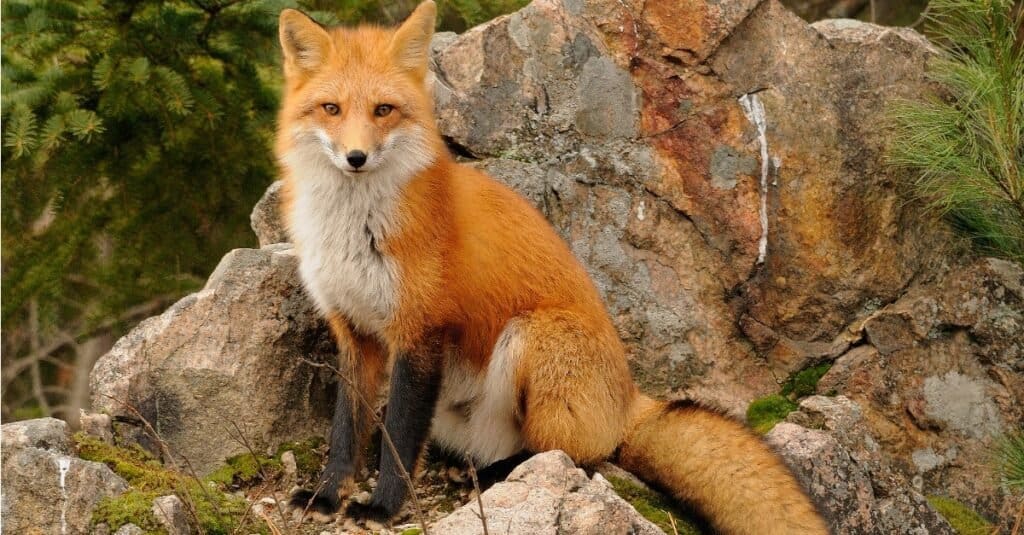
The red fox is just one of 12 species in the Vulpes genus
©iStock.com/Rejean Bedard
The scientific name of the red fox is Vulpes vulpes, which means simply fox in Latin. Due to its widespread distribution, there are more than 40 subspecies of the red fox currently recognized. The red fox itself is just one of 12 species in the Vulpes genus along with the big-eared Fennec fox, the all-white Arctic fox, and the Bengal fox. The larger taxonomical family to which the red fox belongs is called by the scientific name of Canidae. It also includes wolves, domesticated dogs, and all other foxes.
Types
There are 44 subspecies of red fox including:
Afghan red fox V. v. griffithi
American red fox V. v. fulva
Anadyr fox V. v. beringiana
Anatolian fox V. v. anatolica
Arabian red fox V. v. arabica
Atlas fox V. v. atlantica
Barbary fox V. v. barbara
British Columbia red fox V. v. abietorum
Evolution
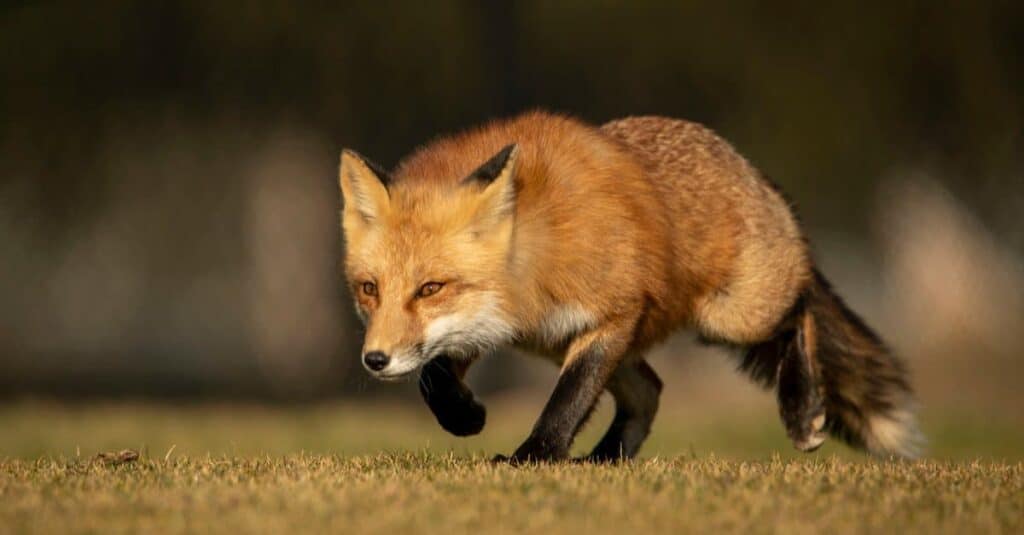
The red fox has Eurasian origins and reached America in two phases
©Jackie Connelly-Fornuff/Shutterstock.com
The earliest fossil evidence of the red fox comes from the middle of the Pleistocene period which itself occurred between 11,570 – 2,580,000. Based on that evidence found in Hungary, experts assert that the red fox has Eurasian origins.
They also believe that the canid reached North America in two stages: the first 130,000 – 191,000 years ago, and the second, between 11,000 – 75,000 years ago.
Paleontologists have also been able to discover fossils from the second period also referred to as the Wisconsinian Glaciation in states such as Arkansas, Colorado, Missouri, New Mexico, Virginia, and Wyoming. Proof that the red fox spread far south, the southwest, and even towards the southeast.
However, it did move northwards as the climate became warmer. Scientists also believe that European and American red foxes have been separated for over 400,000 years.
Appearance
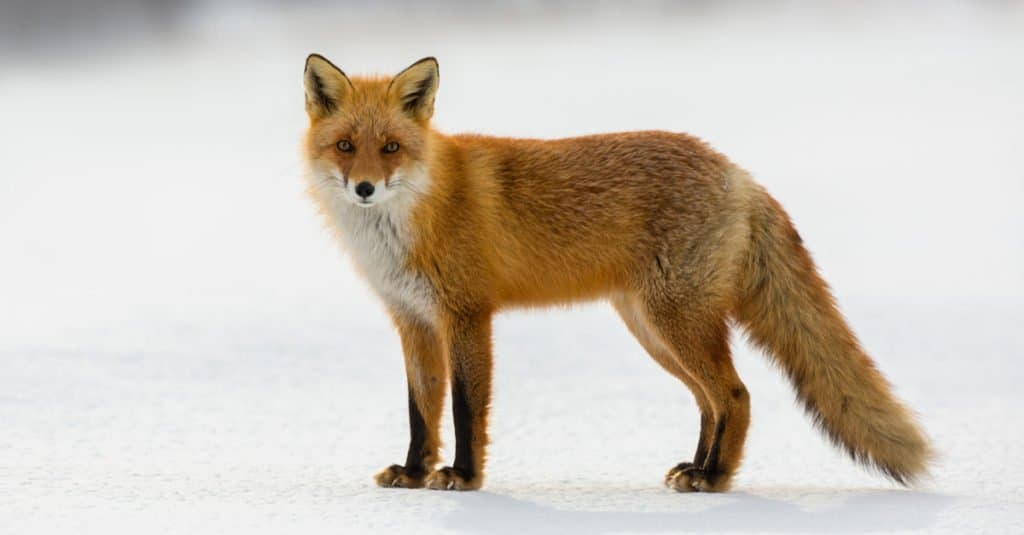
Foxes weigh about 10 – 15 pounds on average
©Michal Dobes com/Shutterstock.com
The red fox is an animal with one of the most recognizable body shapes in the natural world with its slender legs, big bushy tail, pointed ears, and snout. The fur consists of two distinct layers: a coarser outer layer of guard hairs and a softer under a layer of fur. The most common coat color of this species is red-orange with white fur on the lower face, chest, and tip of the tail, plus black fur on the legs and tail. Other common variants include the silver fox (black and silver), the cross or brant fox (yellow-brown and black), and the Samson fox (a wooly coat without coarse guard hairs).
A fully grown adult red fox is small by the standard of many other predators. The body measures about 26 to 42 inches long; about 14 to 16 inches consists of the tail alone. Most adults tend to weigh about 10 to 15 pounds, but some specimens weigh well over 20 pounds. This is about the size of a small domesticated dog. Size varies dramatically by subspecies.
Behavior
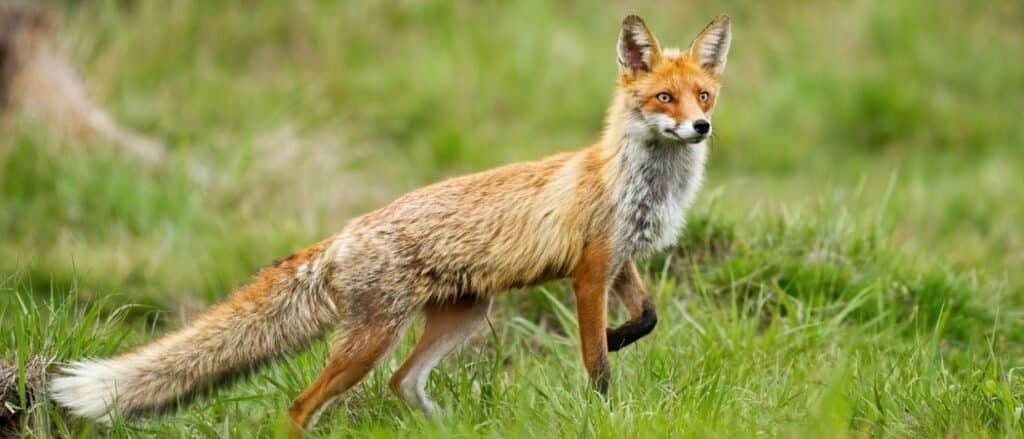
Red foxes are nocturnal by nature and are also impressively nimble and agile
©iStock.com/JMrocek
The red fox is part of the same taxonomical family as the wolf, but its social behavior is quite different. Instead of forming packs, the red fox maintains an exclusive territory with only one adult male and one or two adult females, plus their offspring. These territories can range in size from 5 square miles in areas with abundant resources to 20 square miles in more barren areas.
These family territories consist of a main den (with a few simple passages and rooms) and several temporary or emergency burrows spread throughout the area for safety and rest. The burrows are dug within slopes, banks, ravines, and rock clefts. Although the fox is a proficient digger, it’s often easier for the fox to simply seize a pre-existing den from rabbits, marmots, or other animals. Once under the ownership of the fox, the den sometimes serves as a multi-generational home that’s passed down from parent to child. If the family survives intact, then these homes can sometimes last for decades.
The red fox is most active in the nighttime hours at dusk and dawn when it hunts and forages for food. This species has all kinds of interesting adaptations to help it survive in the wild. With its amazing agility, the red fox can run about 30 mph and leap more than 6 feet in the air. Moreover, the fox’s tail is an important instrument that provides balance and serves as warm cover in cold weather.
The facts suggest that the red fox is a very intelligent species with several different ways to communicate with each other. The body language of the ears, tails, and posture can convey all kinds of social information, including dominant or submissive behavior, playfulness, sexual receptiveness, and much more. Foxes also mark their scents on trees or rocks to announce their presence. These scents are created through urine, feces, and various glands around the body. They have an excellent sense of vision, hearing, and smell. Lastly, they have 28 different kinds of vocalizations, including several variations of barks and whines to interact with each other.
Habitat

Red foxes are adaptable in their choice of habitat and can live in deserts, forests, grassland, and tundra
©iStock.com/William Chua
The red fox is exclusively native to the Northern Hemisphere, including North America, Europe, most of Asia, and North Africa (including the Nile). It was later introduced to Australia in the 19th century, where many people consider it to be a real pest. Where it’s not outcompeted by dingoes, the red fox has been implicated in the decline or extinction of many native Australian mammal and bird species.
With more than 40 subspecies, the red fox is highly adapted to a variety of different habitats, including forests, grasslands, tundra, prairies, mountains, and even deserts. Each subspecies prefers to stay within a specific habitat or a narrow mixture of habitats.
Predators and Prey
One of the more amazing facts about the fox is that they play a role in the ecosystem by keeping the number of small but rapidly reproducing prey species in check. They can also be a nuisance by killing domesticated animals or driving some species to extinction. Foxes are sometimes killed or squeezed out of their habitats where they overlap with larger carnivores, so the decline of their natural predators has lifted some pressure on the red fox populations, causing a boom in numbers.
What does the red fox eat?

The red fox is actually an omnivore, but the bulk of the diet consists of rabbits, mice, voles, birds, frogs, fish, eggs, and even dead carrion. Fruits and vegetables serve as a secondary source of food. This species is just not a particularly picky eater. If the fox ventures close to humans, it also has no particular compunction about eating leftover garbage or pet food. The red fox needs to eat around 1.1 to 2.2 pounds of food every single day to survive. It will store any extra food from its diet in various locations around its territory.
What eats the red fox?

Wolves are one of the main predators of red foxes
©AB Photographie/Shutterstock.com
The fox’s main competitors are wolves, cougars, lynxes, and bobcats, some of which actually kill foxes without the intention to eat them. Eagles and owls are also known to prey on younger kits.
Reproduction, Babies, and Lifespan
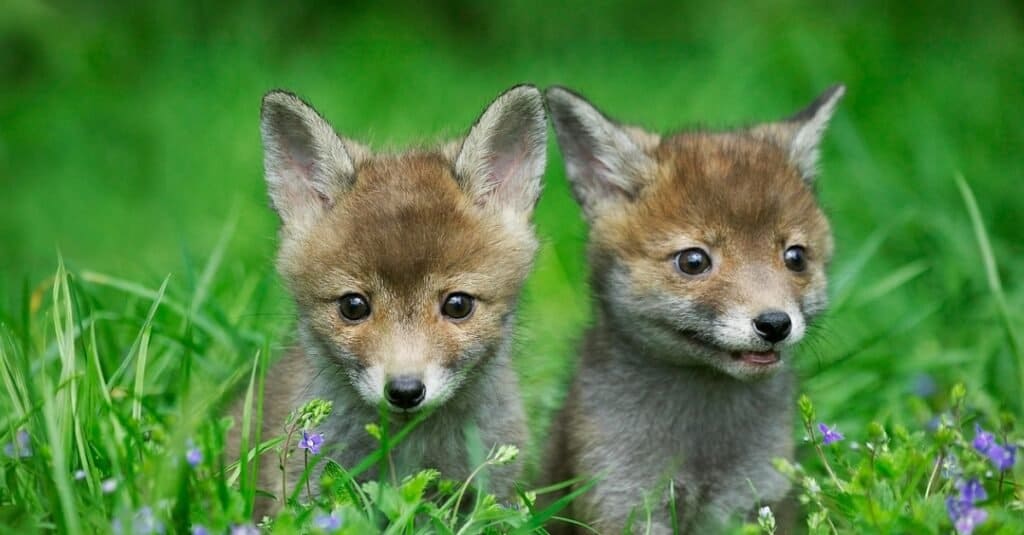
Red foxes are capable of giving birth to as many as 13 kits at a time
©iStock.com/slowmotiongli
The red fox’s mating strategies span the entire spectrum between fully monogamous and fully polygamous. Some foxes stick to a single mate, while others breed with multiple mates. However, no matter how many mates she has, the female only tends to form a bond with a single mate.
Mating season tends to take place in winter or early spring, but the female fox is only in heat for a short period of time, so males sometimes engage in fierce competition with others for access to reproductively available females.
After a gestation period of 56 to 70 days, the female gives birth to a litter of up to 13 kits (though five is the average). When it’s first born, the fox is completely blind and helpless. It has a brown or gray fur color, which will develop into the final color after about a month.
Family cohesion is a very important element of its survival. Both parents and the older offspring play an important role in raising the young kit. The father supports the mate and its offspring by providing food, but it never actually ventures into the maternity den. By the autumn, the young kits are ready to start a new independent life on their own.
In captivity, where it’s free from most predators and diseases, the red fox can live about 10 to 12 years. But in the wild, the life expectancy is only about two to four years. Most fall victim to predators or diseases before they can die of natural causes.
Population
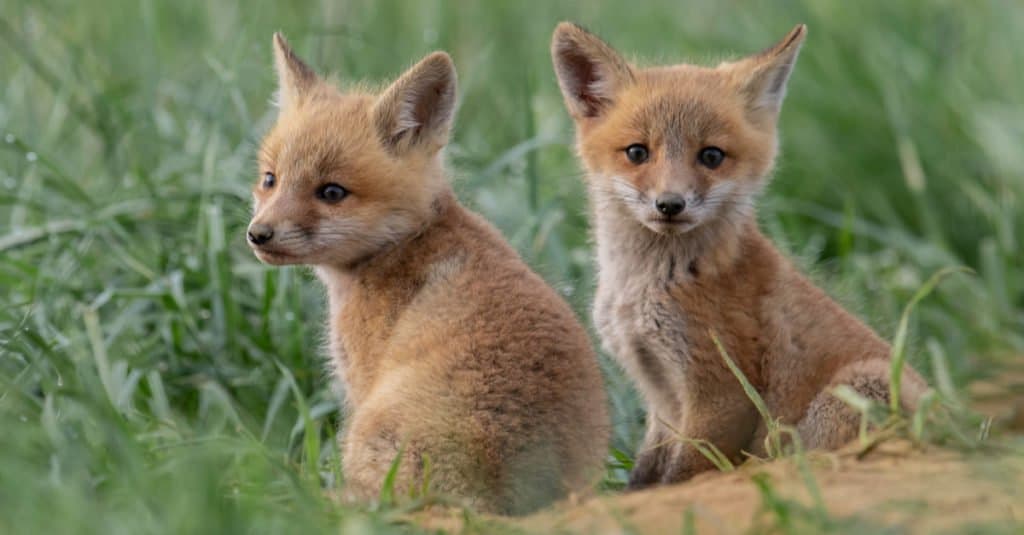
The population of red foxes is unknown; however, it is believed to number in the tens or hundreds of millions
©iStock.com/Harry Collins
Though still hunted for sport, fur, or just to remove it from the environment, the red fox is one of the most widespread carnivorous mammalian species in the world, perhaps because it has benefited from human activity more than it’s been harmed by humans. Exact population numbers are not known, but they are likely to be in the tens or hundreds of millions worldwide. The IUCN Red List currently classified it as a species of least concern, the highest possible classification. This means it requires no special conservation efforts to survive.
In Zoos
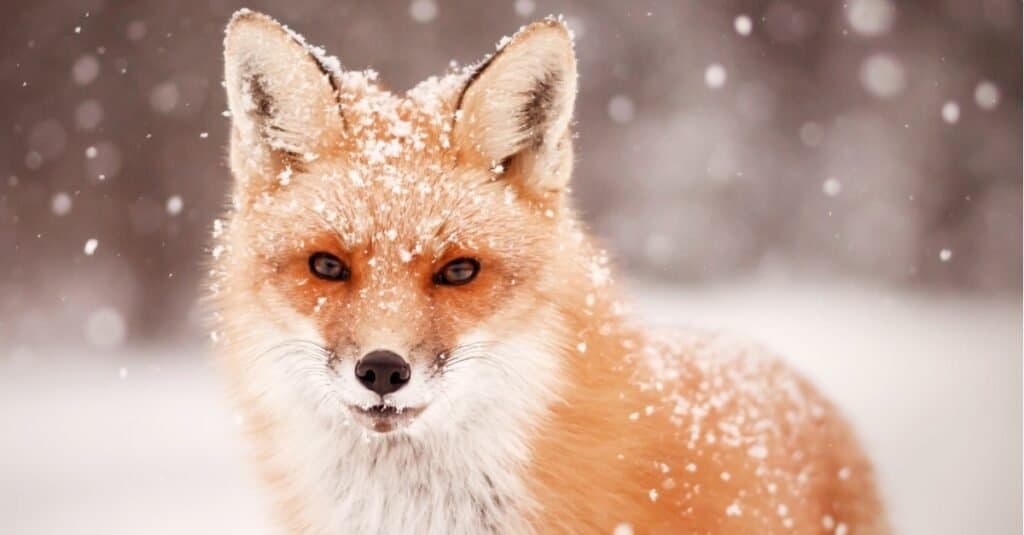
Red foxes are a popular attraction in many zoos
©iStock.com/The_Near_North
Red foxes are a prominent exhibit at many zoos across the country such as Zoo Idaho in Pocatello, the Brevard Zoo in Melbourne, Florida, the Cosley Zoo in Wheaton, Illinois, the Little Rock Zoo in Arkansas, the Big Bear Alpine Zoo in San Bernardino, California, the Alaska Zoo in Anchorage, and the Cleveland Museum of Natural History.
Subspecies of Red Fox
Additional subspecies of red fox include:
Cascade red fox V. v. cascadensis
Cyprus fox V. v. indutus
European fox V. v. crucigera
Eastern Transcaucasian fox V. v. alpherakyi
Ezo red fox V. v. schrencki
Hill fox V. v. montana
Iberian fox V. v. silacea
Japanese fox V. v. japonica
Karaganka fox V. v. karagan
Kenai Peninsula fox V. v. kenaiensis
Kodiak fox V. v. harrimani
Korean fox V. v. peculiosa
Labrador fox V. v. bangsi
Newfoundland fox V. v. deletrix
Nile fox V. v. niloticus
Northern Alaskan fox V. v. alascensis
North Caucasian fox V. v. caucasica
North Chinese fox V. v. tschiliensis
Northern plains fox V. v. regalis
Nova Scotia fox V. v. rubricosa
Palestinian fox V. v. palaestina
Sardinian fox V. v. ichnusae
Scandinavian red fox V. v. vulpes
Sierra Nevada red fox or High Sierra fox V. v. necator
South Chinese fox V. v. hoole
Steppe red fox V. v. stepensis
Trans-Baikal fox V. v. daurica
Tobolsk fox V. v. tobolica
Transcaucasian montane fox V. v. kurdistanica
Turkestan fox V. v. ochroxantha
Turkmenian fox V. v. flavescens
Ussuri fox V. v. dolichocrania
V. v. dorsalis
Wasatch Mountains fox V. v. macroura
White-footed fox V. v. pusilla
Yakutsk fox V. v. jakutensis
View all 114 animals that start with RRed Fox FAQs (Frequently Asked Questions)
Are red foxes dangerous?
The red fox poses almost no danger to people, because it would prefer to run away. But if you harass it, then the fox can deliver a vicious bite that may require medical attention.
How big do red foxes get?
Red foxes tend to grow no larger than 42 inches and 24 pounds.
What are the predators of red foxes?
The main predators are the wolves, cougars, lynxes, bobcats, eagles, and owls.
Is it rare to see a red fox?
The red fox is very common throughout the entire Northern Hemisphere, especially the North American, European, and Asian continents. You are more likely to see them in a rural area than urban one, and they tend to be a little shy around people, but urban encounters are not impossible either. Some fox populations may have even have specialized for an urban lifestyle.
Where do red foxes live?
The red fox can be found in forests, grasslands, tundra, prairies, mountains, and deserts.
What do Red Foxs eat?
Red Fox are Omnivores, meaning they eat
What Kingdom do Red Foxes belong to?
Red Foxes belong to the Kingdom Animalia.
How fast is a Red Fox?
A Red Fox can travel at speeds of up to 31 miles per hour.
What are the differences between Grey foxes and Red foxes?
The major differences between the Grey fox and the Red fox are classification, appearance, size, ability, and hunting habits. The Grey fox and the Red fox share many physical characteristics we think of as unique to foxes. Both have long bodies, bushy tails, and large ears commonly associated with foxes. However, the Grey fox has some unique physical traits and abilities.
Thank you for reading! Have some feedback for us? Contact the AZ Animals editorial team.
Sources
- Animal Diversity Web, Available here: https://animaldiversity.org/accounts/Vulpes_vulpes/
- Britannica, Available here: https://www.britannica.com/animal/red-fox-mammal
- National Geographic, Available here: https://www.nationalgeographic.com/animals/mammals/r/red-fox/

















